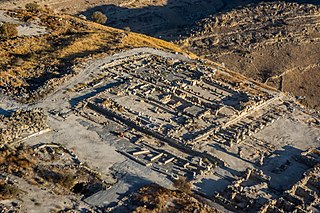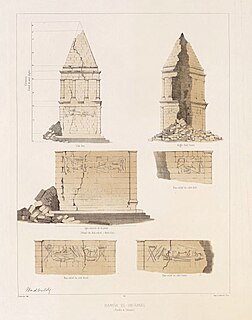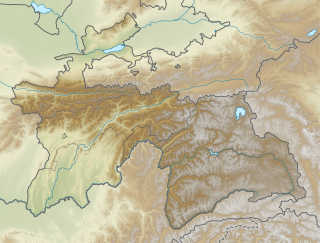 W
WAlexandria Eschate was a city founded by Alexander the Great, at the south-western end of the Fergana Valley in August 329 BCE. It was the most northerly outpost of Alexander's Empire in Central Asia. Alexandria Eschate was established on the south bank of the river Jaxartes, at or close to the site of modern Khujand.
 W
WTel Anafa is an archaeological site and nature reserve in the Upper Galilee, Israel.
 W
WBeit Guvrin-Maresha National Park is a national park in central Israel, 13 kilometers from Kiryat Gat, encompassing the ruins of Maresha, one of the important towns of Judah during the time of the First Temple, and Beit Guvrin, an important town in the Roman era, when it was known as Eleutheropolis.
 W
WEmirzeli (İmirzeli) is a group of ruins in Mersin Province, Turkey
 W
WThe Gadara Aqueduct, also called Qanatir Fir'awn or Qanat Fir'aun, was a Roman aqueduct supplying water for some of the cities of the Decapolis. It serviced Adraha, Abila, and Gadara. The aqueduct has the longest known tunnel of the Classical era.
 W
WHippos is an archaeological site in the Israel-Syria DMZ, on a hill in the northern Jordan Valley overlooking the Sea of Galilee. Between the 3rd century BCE and the 8th century CE, Hippos was the site of a Greco-Roman city, which declined towards the end of the Byzantine period and the Ealy Muslim period, and was abandoned after an earthquake in 749. Besides the fortified city itself, Hippos controlled two port facilities on the lake and an area of the surrounding countryside. Hippos was part of the Decapolis, or Ten Cities, a region in Roman Jordan, Syria and Israel that were culturally tied more closely to Greece and Rome than to the Semitic ethnoi around.
 W
WIkaros was the Hellenistic name of the Kuwaiti Failaka Island, in the Persian Gulf.
 W
WJebel Khalid is an archaeological site in modern Syria. Australian excavations starting in 1986 discovered the remains of a Hellenistic, Seleucid town perhaps founded by Seleucus I Nicator. The town flourished till around 70 BC and was then abandoned. The ancient name is not yet known for sure. Due to the political situation in Syria the excavations stopped in 2010.
 W
WKamouh el Hermel, the Pyramid of Hermel is an ancient pyramid located 6 kilometres (3.7 mi) south of Hermel in Baalbek-Hermel Governorate, Lebanon.
 W
WSeleucia, also known as Seleucia-on-Tigris or Seleucia on the Tigris, was a major Mesopotamian city of the Seleucid, Parthian, and Sasanian empires. It stood on the west bank of the Tigris River opposite Ctesiphon, within the present-day Baghdad Governorate in Iraq.
 W
WTel Erani or Tell esh-Sheikh Ahmed el-ʿAreini is a multi-period archaeological site on the outskirts of Kiryat Gat in the Southern District of Israel. It is also known by the name ʻIrâq el-Menshiyeh, although thought to have borne the original Arabic name of Menshiyet es-Saḥalīn. The tell was first occupied in the Chalcolithic period, but its most notable remains are from the Bronze Age and Iron Age, when it was the site of a substantial Philistine city with links to Egypt. It has been identified with the biblical cities of Libnah, Gath, Mmst, Eglon and Makkedah, but none of these identifications are certain. The city was destroyed in the 6th century BCE, possibly by the Babylonians. In the Persian period, it was the site of a temple. There are also signs of settlement in the Hellenistic, Byzantine, and Mamluk periods. The Palestinian village of Iraq al-Manshiyya was located at the foot of the tell until it was depopulated in the 1948 Arab–Israeli War.
 W
WTel Yokneam, also spelled Yoqne'am or Jokneam, is an archaeological site located between the modern city of Yokneam Illit and the town of Yokneam Moshava. It was known in Arabic by a variant name, Tell Qamun, believed to be a corruption of the Hebrew name. The site is an elevated mound, or tel, spanning around 40 dunams and rising steeply to a height of 60 meters (200 ft). With a few brief interruptions, Yokneam was occupied for 4,000 years, from the Middle Bronze Age to the Ottoman Empire.
 W
WTorbulok is an archaeological site located in a foothill zone 50 km northwest of the Kyzylsu river valley and 20 km southeast of Danghara in the south of present-day Tajikistan. The site lies at the foot of the Čaltau mountain range. It was the site of a small sanctuary during the Hellenistic period, when the area was part of the Greco-Bactrian kingdom.